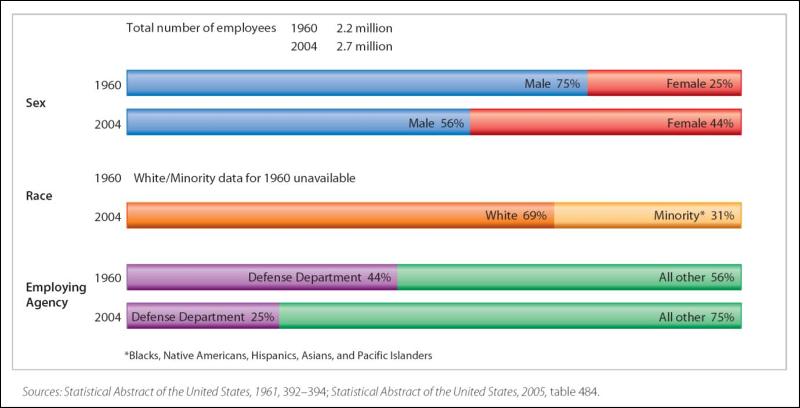Proxy Government
“Government by proxy”--refers to the practice of the federal government paying state and local governments and private groups to staff and administer federal programs.
The war in Iraq and Hurricane Katrina are examples of “proxy government” efforts
The United States Bureaucracy
Bureaucracy: a large, complex organization composed of appointed officials
Political authority over the bureaucracy is shared by president and Congress
Federal agencies share functions with related state and local government agencies
Growth of the Bureaucracy UP TO THE CIVIL WAR
Patronage in the 19th and early 20th centuries rewarded supporters, induced congressional support, and built party organizations
The Civil War showed the administrative weakness of the federal government and increased demands for civil service reform
Growth of the Bureaucracy POST CIVIL WAR
The post-Civil War period saw industrialization and the emergence of a national economy
The power of national government to regulate interstate commerce became necessary and controversial
Expansion of the Bureaucracy
The Depression and World War II led to government activism
The Supreme Court upheld laws that granted discretion to administrative agencies
Heavy use of income taxes supported war effort and a large bureaucracy
The Impact of 9/11
9/11 attacks could also affect the bureaucracy as profoundly as WWII and the Depression
A new cabinet agency (Department of Homeland Security) was created
Intelligence-gathering activities were consolidated under a National Intelligence Director
Growth of the Bureaucracy Today
Modest increase in the number of government employees
Significant indirect increase in number of employees through use of private contractors, state and local government employees
Growth in discretionary authority
Recruitment and Retention
Competitive service: bureaucrats compete for jobs through OPM
Appointment by merit based on written exam or through selection criteria
Figure 15.1 Characteristics of Federal Civilian Employees, 1960 and 2004

Recruitment and Retention
Competitive service system has become more decentralized, less reliant on OPM referral
Excepted service: bureaucrats appointed by agencies, typically in a nonpartisan fashion
Firing a Bureaucrat
Most bureaucrats cannot be easily fired
The Senior Executive Service (SES) was established to provide the president and cabinet with more
control in personnel decisions
But very few SES members have actually been fired
Carrying Out Policy
Most bureaucrats try to carry out policy, even those they disagree with
But bureaucrats do have obstructive powers—Whistleblower Protection Act (1989)
Most civil servants have highly structured jobs that make their personal attitudes irrelevant
Constraints on the Bureaucracy
Constraints are much greater on government agencies than on private bureaucracies
Hiring, firing, pay, and other procedures are established by law, not by the market
Constraints come from citizens: agencies try to respond to citizen demands for openness, honesty, and fairness
Agency Allies
Agencies often seek alliances with congressional committees and interest groups
These alliances are far less common today—politics has become too complicated
Issue networks: groups that regularly debate government policy on certain issues
Congressional Oversight
Congress creates agencies
Congress authorizes funds for programs
Congressional appropriations provide funds for the agency to spend on its programs
Congressional investigations
Bureaucratic Pathologies
Red tape: complex, sometimes conflicting rules
Conflict: agencies work at cross-purposes
Duplication: two or more agencies seem to do the same thing
Imperialism: tendency of agencies to grow, irrespective of programs’ benefits and costs
Waste: spending more than is necessary to buy some product or service
Reforming the Bureaucracy
National Performance Review (NPR) in 1993 designed to reinvent government calling for less centralized management, more employee initiatives, fewer detailed rules, and more customer satisfaction
Reforming the Bureaucracy
Most rules and red tape are due to struggles between the president and Congress or to agencies’ efforts to avoid alienating influential voters
Periods of divided government worsen matters, especially in implementing policy